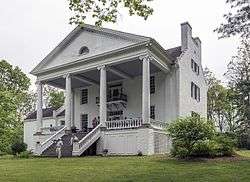Falling Spring-Morgan's Grove
|
Falling Spring--Morgan's Grove | |
 Falling Spring in 2017 | |
  | |
| Nearest city | Shepherdstown, West Virginia |
|---|---|
| Coordinates | 39°25′15″N 77°48′55″W / 39.42083°N 77.81528°WCoordinates: 39°25′15″N 77°48′55″W / 39.42083°N 77.81528°W |
| Built | 1734 |
| Architect | Edmonds, Stuart H. |
| Architectural style | Classical Revival, Federal |
| NRHP Reference # | 88002670[1] |
| Added to NRHP | February 15, 1989 |
Falling Spring at Morgan's Grove is part of a related complex of buildings and lands associated with the Morgan family and other prominent members of the Shepherdstown, West Virginia community. Falling Spring was completed by 1837 as a large, porticoed stucco house and farm complex. The property was first settled by Richard Morgan, who noted several springs on the property, including "Bubbling Spring" and "Morgan's Spring", the starting point of the 1775 Bee-Line March. The house was built by Jacob Morgan, Richard's grandson, who was a successful merchant who lived and worked in Alexandria, Virginia.
Richard's son William inherited the property in 1855. William Morgan became a Confederate officer with the start of the American Civil War, serving with Generals J.E.B. Stuart and Turner Ashby.
Falling Spring was sold in 1904 to Dr. M.H. Crawford, who added two more columns to the portico. The design may have been undertaken by Winchester, Virginia architect Stuart H. Edmonds, who had worked at Shepherd College and Bellevue. The Crawfords also added a Japanese garden to the property.[2]
References
- ↑ National Park Service (2008-04-15). "National Register Information System". National Register of Historic Places. National Park Service.
- ↑ Diana Suttenfield with Rodney S. Collins (August 12, 1988). "National Register of Historic Places Nomination: Morgan's Grove" (pdf). National Park Service.
External links
- Historic American Buildings Survey (HABS) No. WV-33, "Jacob Morgan House, Shepherdstown vicinity, Jefferson County, WV", 2 photos
| Wikimedia Commons has media related to Falling Spring-Morgan's Grove. |
